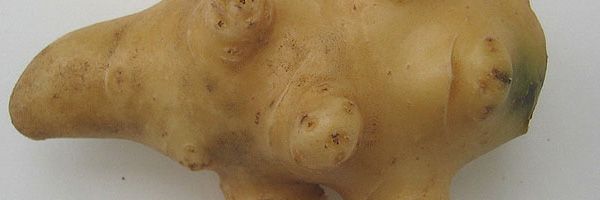
Secondary growth: deformed and glassy tubers
The phenomenon of secondary growth is the result of alternating periods of growth and non-growth during the growing cycle. It is the cause of anomalies that can develop in different forms: chain tuberisation, tuber sprouting, tuber formation in gemmation, deformed tubers (photo 1) and, in severe cases, production of glassy tubers.
- Symptoms
The shape of the tubers depends on the time when the change of climatic conditions occurs during the growing process:
- if it occurs at the beginning of tuber formation, interrupted growth causes a constriction at the basal end (pear-shaped tuber, photo 2);
- if it occurs in the middle of tuber formation, the two parts formed may be of similar size (dumbbell-shaped tuber or ridge roller, photo 3);
- if it occurs at the end of tuber formation, an excrescence develops at the tip of the rose- end (sucker). Sometimes, such growth occurs at several lateral eyes, giving protuberances of various shapes and sizes (tuber with multiple knobs, photo 4).
Glassiness (photo 5 and 6), which results from deformations or tuber formation in gemmation, is expressed in the appearance of more or less translucent areas inside the flesh. These are caused by the partial or total disappearance of the starch grains in the tissues concerned (photo 7). These tubers are unsuitable for any use whatsoever and, in the worst affected cases, can result in partial or total liquefaction during storage. In the case of seed potatoes, severely affected tubers germinate badly and give stunted plants.
- Risk factors
Tuber formation is characterised by both longitudinal growth and diametric growth of the stolon; stopping its elongation appears essential to the enlarging of the tuberising end. The balance depends on environmental conditions: long days and high temperatures favour the development of foliage and the elongation of stolons, whereas short days and low temperatures activate tuber formation.
In a temperate climate, in periods of active vegetation, this balance is obtained after a long time: there is simultaneous growth and tuber formation, with the latter gradually becoming predominant.
If conditions are not favourable to tuberisation, chiefly a temperature above 25°C, it stops. The stolons elongate, branch out and, sometimes, are transformed into aerial stems. The tubers resume their growth and become deformed.
In cooler conditions (overcast weather, rain, excessive irrigation), new tubers form along the stolons, stopping the development of the initial tubers that have already formed.
Glassiness generally occurs when the leaves turn yellow after haulm destruction. This phenomenon is explained by the fact that in the active vegetation phase, the young tubers are supplied with carbohydrates by the aerial parts of the plant. When the foliage is no longer functional, the second generation tubers draw sugars from the oldest tubers, whose starch is hydrolysed and their specific weight reduced. A similar phenomenon can be observed in some deformed tubers in which starch is translocated to the rose-end area from the heel-end (“glassy end”).
- Control measures
A few essential rules for limiting secondary growth:
- in difficult situations, susceptible cultivars are to be avoided (e.g. Bintje, BF 15, Roseval, Russet Burbank, etc.). Early cultivars and cultivars with rounded or short oblong tubers are generally less susceptible than those with elongated tubers;
- good cultivation practice: avoiding irregular growth, good soil structure, appropriate seed density, attention paid to the volume of ridges, appropriate nitrogen input and irrigation. Additionally, trials have shown that the application of maleic hydrazide can partially limit secondary growth and the formation of glassy tubers in years favourable to this phenomenon.
- destroy the haulms when the second generation of tubers appears; these will be small enough to be eliminated when graded. If, for reason of yield, haulm destruction is delayed, the time spent by tubers in the soil should be kept to a minimum to reduce glassiness.





